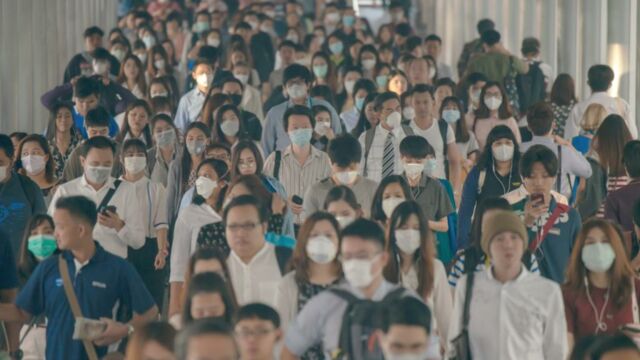Outbreak of unknown infection in China: Here’s when the ‘ferocious’ epidemic is expected to peak

As reports of the new outbreak of respiratory illnesses in China circulate, people are concerned virus history could repeat itself.
Back in December 2019, ProMed - a surveillance programme run by the International Society for Infectious Diseases - reported on a health scare in Wuhan, China. As we all remember far too clearly, this ended up being Covid-19. The spread of this virus caused a global pandemic, the effects of which we are still dealing with today. Some who got long Covid have been battling against the virus for years, unable to work and frustrated by their situation.
Discover our latest podcast
On Tuesday 21 November, Pro Med issued another report about an apparent epidemic in China. This time, the surveillance programme alerted the public to a surge of ‘undiagnosed pneumonia’ in children. Many suspect that the Chinese government’s resistance to give full disclosure back in 2019 contributed to the spread of the coronavirus, and there is concern that history could repeat itself. So, here’s what we know so far, what the World Health Organisation has said, and how China has reacted.
More under this adMore under this adWhat we know so far
Much of what we know so far has come from the Taiwanese media outlet FTV News. Their report, which is yet to be corroborated, stated that hospitals in the Hebei province and neighbouring Liaoning are ‘overwhelmed with sick children’. These north-eastern areas are seeing children affected with symptoms potentially associated with pneumonia.
However, one Beijing citizen who spoke to FTV News explained that are asymptomatic:
Many, many are hospitalised. They don’t cough and have no symptoms. They just have a high temperature (fever) and many develop pulmonary nodules.More under this adMore under this ad
Worryingly, FTV also reported that adult teaching staff have been infected as well.
What the World Health Organisation has said
Back in 2019, the WHO asked Chinese authorities for more details about the beginnings of what turned out to be Covid-19. They took three days to reply, referring to a ‘cluster of pneumonia cases of unknown cause’. The similarities between these two cases are obvious, and as The Telegraph’s Mathew Henderson says:
What many now believe to be the ‘managed’ flow of incomplete, ambiguous and unreliable data fed to the WHO by the Chinese government has gone down in history as a major potential contributor to the subsequent spread of Covid-19.More under this adMore under this ad
Henderson asks whether there’s a risk of history repeating itself as the WHO has issued an 'official request to China for detailed information' about this new outbreak.
However, Maria Van Kerkhove, WHO's interim director for epidemic and pandemic preparedness and prevention, has some reassuring news to announce yesterday, 23 November. She explained that the illnesses are coming from known pathogens:
More under this adMore under this adEssentially what China has been observing and picked up through their national surveillance systems is an increase in respiratory infections across the board, but mainly among school-aged children, and this is due to a number of pathogens that are known.
How China has reacted
It is thought that this surge in respiratory diseases could be due to China lifting its Covid-19 restrictions. This happened at the start of the year, and the country could be seeing the effects of its young people not having been exposed to germs over the pandemic period. Other countries, including the UK, also saw an increase in respiratory diseases after lifting social distancing rules.
More under this adMore under this adZhou Huixia, director of the children's medical centre at the Seventh Medical Center of the Chinese PLA General Hospital, spoke to China Daily about the outbreak:
It is the first wave of mycoplasma pneumoniae infections since most COVID-19 containment measures were lifted at the beginning of this year.More under this adMore under this ad
The wave has appeared particularly ferocious since the National Day holiday in early October. Compared to previous years, we found more patients with mixed infections, drug resistance and lobar pneumonia.
She explained that the ‘intense’ surge of infections is expected to peak this month. This may come alongside an increase in other infections, but so far there is no evidence to suggest the virus will spread much further.
More under this adMore under this adRead more:
⋙ Covid-19: Do at-home tests detect the new variants? Here's what an expert has to say
⋙ Covid-19: This is what it’s really like to have the virus in 2023
⋙ Covid-19: Who is eligible for the vaccine tackling new variant Pirola?
Sources used:
The Telegraph: China can’t be allowed to let virus history repeat itself
Express: Everything we know so far as China in grips of new respiratory illness causing pneumonia